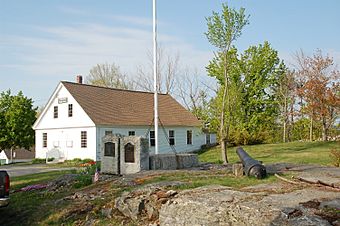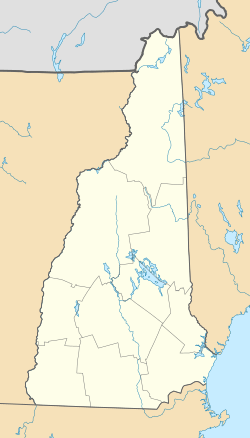Lyndeborough Center Historic District facts for kids
Quick facts for kids |
|
|
Lyndeborough Center Historic District
|
|

The Hartshorn Cannon, flagpole, and war memorials, April 2010. The Old Town Hall sits behind them. Behind that is the former Town Highway Barn.
|
|
| Location | Center Rd Lyndeborough, New Hampshire |
|---|---|
| NRHP reference No. | 84002814 |
| Added to NRHP | June 7, 1984 |
The Lyndeborough Center Historic District is a special area in Lyndeborough, New Hampshire, United States. It includes three important buildings: the Town Pound, the Town Hall, and the Congregational Church. This district was added to the National Register of Historic Places in 1984. This means it's recognized as a place important to American history. In 2010, the town decided to make this area part of a larger, officially protected local historic district.
Contents
The Old Town Pound
The Town Pound is a square stone building. It has an open top and you enter through a gate. It was built in 1774. Long ago, it had a wooden fence on top. Pounds were used to hold stray animals until their owners claimed them.
Lyndeborough Town Hall
The current Town Hall is Lyndeborough's third town hall building. It's the second one to be on this spot in the Historic District. The town's second Town Hall was a large meetinghouse, about 50 by 40 feet. It stood here from around 1769 until 1845.
Building the Current Town Hall
The current Town Hall is a 1.5-story building. It is built in the Greek Revival style, which was popular in the 1800s. It was constructed in 1845-46. At first, it was about 35 by 40 feet. It had a meeting hall and one small front room.
Changes Over Time
In 1883, the town made the building much bigger. They removed the back wall and added a 12.5-foot deep section. They also added new walls inside. This created a kitchen area and a small entry space.
In 1890, the roof was made steeper. This added more space in the attic for dinners and other events. A new section, called an ell, was added to one corner. A metal roof was put on, but it was removed in 1919. A metal ceiling was installed in the meeting room in 1913. An Arts-and-Crafts-style stage was added between 1913 and 1919. A second chimney was built behind the stage in 1920. A storage area was added to the back in 1913. The attic was updated in 1934. Electricity was installed in 1937. Since 1975, the building has been shown on Lyndeborough's unofficial town seal.
The Congregational Church
The Congregational Church is also built in the Greek Revival style. It dates back to 1837. At that time, the church moved out of the third town hall building.
Church History and Changes
The church steeple was shortened sometime in the 1800s. This happened after it was hit by lightning. The whole steeple might have been rebuilt before or during the mid-1850s. That's when the church bell was added. The inside of the church was greatly changed in the 1890s. The entire building had major repairs in the mid-1980s.
Today, the church is controlled by the United Church of Lyndeborough. This happened after the Baptist and Congregationalist churches in town joined together. The building is not heated, so it is mainly used for summer services. From 1837 until about 1920, horse sheds were located between the church and the Town Pound.
Roads and Stone Walls
Three roads go through the Historic District. Center Road is a paved, state-maintained road. Stone Bridge Road is an unpaved town road that is not maintained. There is also an unnamed unmaintained road. It connects Center Road to a lower part of Stone Bridge Road.
Center Road
Center Road was first created before 1770. It was about 33 feet wide. It was made wider to 50 feet between 1800 and 1804. This was part of a project to build a road across Hillsborough County. The road was widened again in 1840. This was because of problems with blowing snow. The original part of Center Road ran closer to the Old Town Hall, Town Pound, and Church. After 1840, people mostly stopped using it for travel. It is now part of the town common area.
Stone Bridge Road
Stone Bridge Road is about 33 feet wide. It was built in 1770. It connected Lyndeborough Center to the western part of Lyndeborough. This road helped people travel from the Town Hall to other areas.
Unnamed Road
The unnamed road appears on an 1858 map. Like Stone Bridge Road, it was not used much after 1892. However, it was never officially closed. This means it is still legally a public road. Its exact width is not known, but it is thought to be about 33 feet.
Stone Walls
The stone walls behind the Town Pound, Town Hall, and former Town Barn were built around 1800. The stone wall along the east side of Center Road was built in 1840. This was when the road was moved to its current spot.
The Town Common
The Town Common is the open area between the Town Hall and the Congregational Church. It also runs in front of the church and Town Pound. This common area was created in 1840. This happened when Center Road was moved to its current location. The town still has the right to use this space for public events.
History of the Common
The land around the Town Hall has been called the "Common" since at least 1770. This was when the first meetinghouse was built here. The common originally stretched from the Town Pound to the Center Cemetery. The cemetery was added around 1800. In 1817, the town sold a small piece of the common. This money was used to fix the original meetinghouse. Today, that land is a privately owned apple orchard. Another area west of the meetinghouse became private property in the 1800s. But it was given back to the town in 2001.
In 1940, a flagpole was added to the common. The current flagpole, made of fiberglass, was put up around 1999.
The Town Barn
The historic district also includes the Town Barn. This building is newer and does not add to the historic value of the district. It was built around 1938. It was used by the town's highway department until the mid-1980s. In 1997, the town rented it to the Lafayette Artillery Company for 99 years. It still serves as their headquarters. The building is next to where the town's old hearse house used to be.
Who Manages the District?
Several groups help manage the properties in the Lyndeborough Center Historic District.
- The Board of Selectmen controls the Town Hall, Town Pound, common, and roads.
- The Lyndeborough Highway Department takes care of the grounds.
- The local Cemetery Trustees manage the cemetery.
- The Lafayette Artillery Company rents the Town Barn.
- The United Church of Lyndeborough controls the church building.
- Since 2010, the Lyndeborough Center Historic District Commission has overseen historic preservation and zoning for the whole district. They focus on keeping the Town Hall in good condition. They set rules for the district in 2012.
- The Lyndeborough Trails Association works to improve Stone Bridge Road for horse riders.



